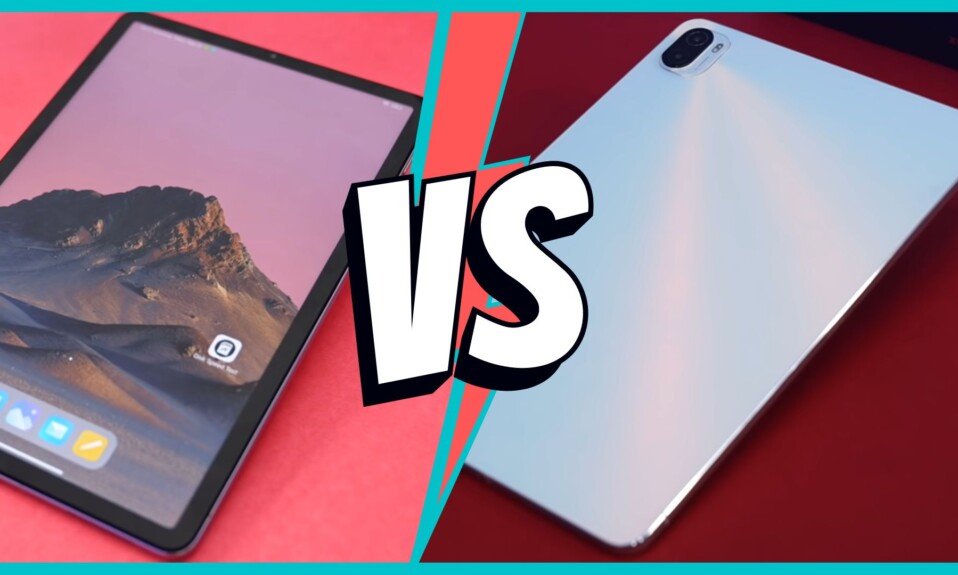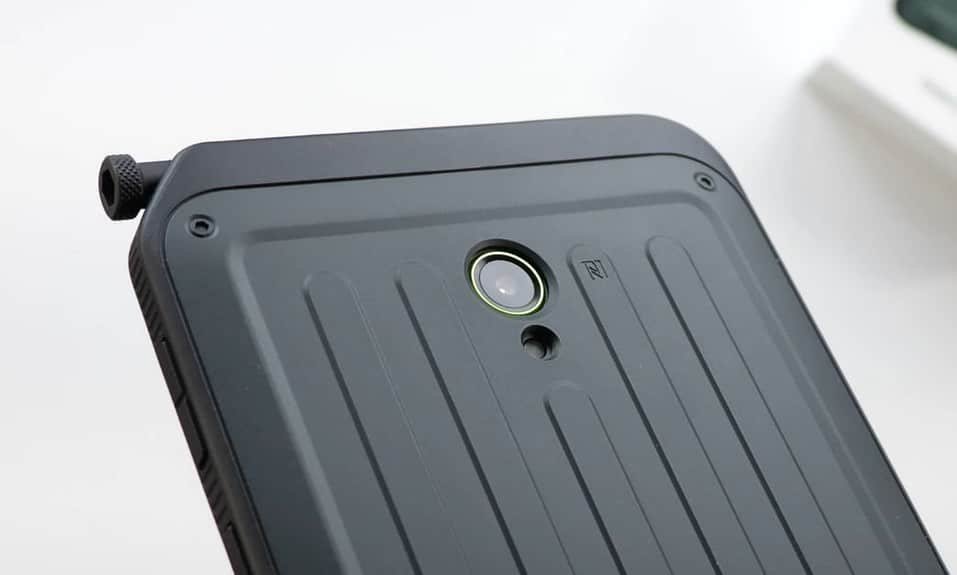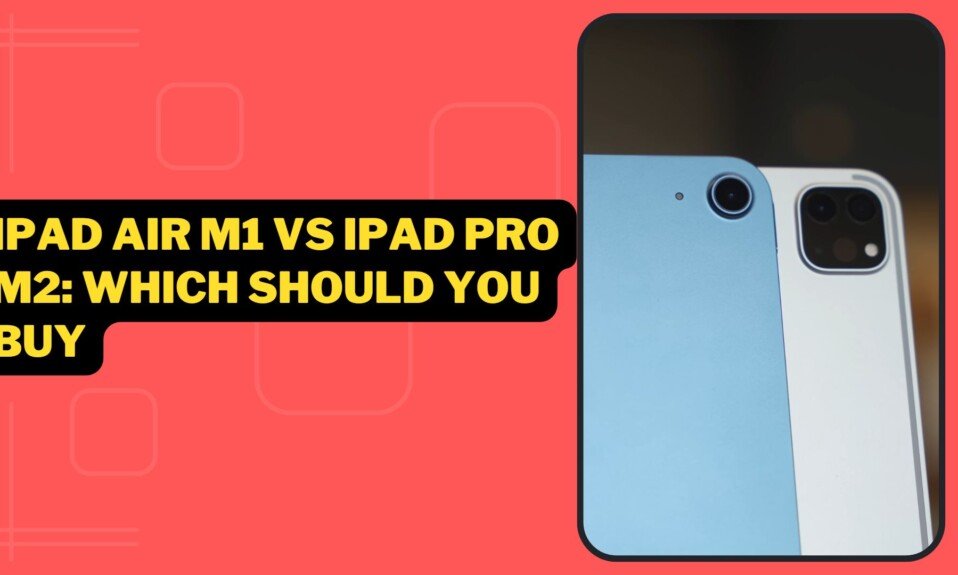It’ll be exciting to see how well the Xiaomi tablets do. The Xiaomi Pad 5 costs $369.99; the Chinese import version is slightly more. The design, construction, feel, performance, and 120 Hz display make you happy. The Pad 5 and Pro are nearly identical.
The Pro has a faster processor, a better camera (5G version), faster charging, and the option to connect to 5G. If you need these features, choose the Pro version; otherwise, you can get the same user experience with the vanilla version. At least for now, the Pro variant is only available in the Chinese market, while the vanilla version is available globally. Which one would you pick?
See the detailed review: Xiaomi Mi Pad 5 Pro
| Xiaomi Pad 5 Pro | Xiaomi Pad 5 | |
|---|---|---|
| Dimensions | 254.7 x 166.3 x 6.9 mm | 254.7 x 166.3 x 6.9 mm |
| Weight | 515 g 518 g (5G) | 511 g |
| Display | 11 inches | 11 inches |
| Pixel | 1600 x 2560 | 1600 x 2560 |
| CPU | Snapdragon 870 | Snapdragon 860 |
| GPU | Qualcomm Adreno 650 | Qualcomm Adreno 640 |
| Memory | 6 GB RAM, 128 GB 6 GB RAM, 256 GB 8 GB RAM, 256 GB | 6 GB RAM, 128 GB 6 GB RAM, 256 GB |
| Software | Android 11, MIUI | Android 11, MIUI |
| WIFI | Wi-Fi 802.11 a/b/g/n/ac/ax | Wi-Fi 802.11 a/b/g/n/ac |
| Bluetooth | Bluetooth 5.2 | Bluetooth 5.0 |
| Rear camera | 5G version: 50MP + 5MP depth information WiFi: 13MP + 5MP depth information | Single 13 MP f/2.0 |
| Front camera | 8MP | 8MP |
| Speaker | 8 speakers/4 microphones | 4 speakers/2 microphones |
| Unlock method | Face Unlock + Fingerprint Unlock | Face Unlock |
| Battery | 8600mAh | 8720 mAh |
| Fast charging | 67W | 33W |
Design
The Xiaomi Pad 5 Pro in the 6/128GB version that we ordered is a piece of cake in terms of looks, feel, and fit and finish. It is not required to hide from the competition.
The device’s beveled edges and curves, as well as the fact that it is made of metal, show that it is well made. It’s comfortable to hold and not too heavy. However, for long-term use, I prefer two-handed operation.

The power button also has a fingerprint reader built in. But this button would have stood out more in the thin frame if it had been put in a different place. On the other hand, the volume buttons are the usual size and easy to use.
Xiaomi, as in the past, frequently follows Apple models when designing its own products. The Mi Pad 5 and Mi Pad 5 Pro are also designed after the Apple iPad Pro 2021. As a result, Xiaomi uses an angular design with rounded corners. However, you must be realistic, as many manufacturers refer to this, admittedly, chic and practical look.
Xiaomi runs MIUI 12 and has chosen an Apple-style notification system. Pulling your finger down on the upper right edge gives you access to WLAN, Bluetooth, and other features, but with an Apple-like appearance. Swiping left from top to bottom brings you to the message centre, where all incoming e-mails or messages are accumulated as usual.

Pad 5 Pro model almost identical to Pad 5
There are no differences between the normal and Pro models in terms of how they look. Neither in how it works nor in how good the IPS screen is.
- The non-pro version doesn’t have a fingerprint scanner, but the pro version does, making it easy to unlock.
- Non-pro version has 4 speakers, while pro has 8.
- The non-pro version has 6 GB of LP DDR4X RAM, while the pro version has LP DDR5X RAM, which means a faster transfer speed and better efficiency.
- The non-pro version has a larger 8720mah battery and supports 33 watt fast charge. The pro version has a smaller 8600mah battery but significantly faster charging speeds and 67 watt fast charge. If you’re always on the go and need fast charging speeds, the 67 watt fast charge shield won’t disappoint.
Display
The game continues in accordance with the size of the display. There are manufacturers who use the traditional 10.1 inch screen, but many new devices use 11 inches. The Pad / Pro’s LCD display measures 10.95 inches and has a resolution of 2560 x 1600 pixels. All of this is combined with a refresh rate of 120Hz for a clean, fast display in the system.

All Xiaomi Pad 5 and Pro models have the same display. The pixel density is 275 ppi and the maximum brightness is 500 nits. At 1500:1, the contrast ratio is rather low.

The display immediately pleases us, and we don’t need to use full brightness inside. You’re doing well with 50-80%. So far, the LCD display can play back HDR content, which is a plus. However, in order to fully utilise the potential, the brightness should be increased.
120Hz refresh rate provides a smooth user experience. It’s reflected in apps and games that support it. Everything tested runs smoothly and quickly with no restrictions.
Pad 5 and Pad 5 Pro have identical displays. No differences, thankfully. The Pro model’s display settings are identical. There’s also pen and magnetic keyboard support. As with the import model, you must buy both separately.
Performance
Like the last one, there are now two versions that are a little bit different from each other. So, besides the fact that the Pro model comes with WiFi and 5G, the Xiaomi Pad 5 has a Snapdragon 860, which is a new version of the Snapdragon 855+. The Pad 5 Pro, on the other hand, runs on the Snapdragon 870, which is a bit faster (new version of the Snapdragon 865).
So the performance is slightly different, but thanks to the new versions of their high-end processors, both versions have more than enough performance to keep up in everyday life and in games.
We rarely talk about RAM, but in this case, there is a difference between the two devices. The non-pro version has 6 gigabytes of ram, but it’s LP DDR4X. The pro version has 6 gigabytes of ram, but it’s LP DDR5X. An improvement in ram means a slightly faster transfer speed and better efficiency.
Benchmark results of the Xiaomi Pad 5 Pro
In a stylish case, there is high-end hardware that makes the system and built-in processor work well. There is nothing wrong with this place at all. Both the system and the benchmarks have high-end performance. Even more so, because the read and write speeds of DDR5 RAM are also very good.
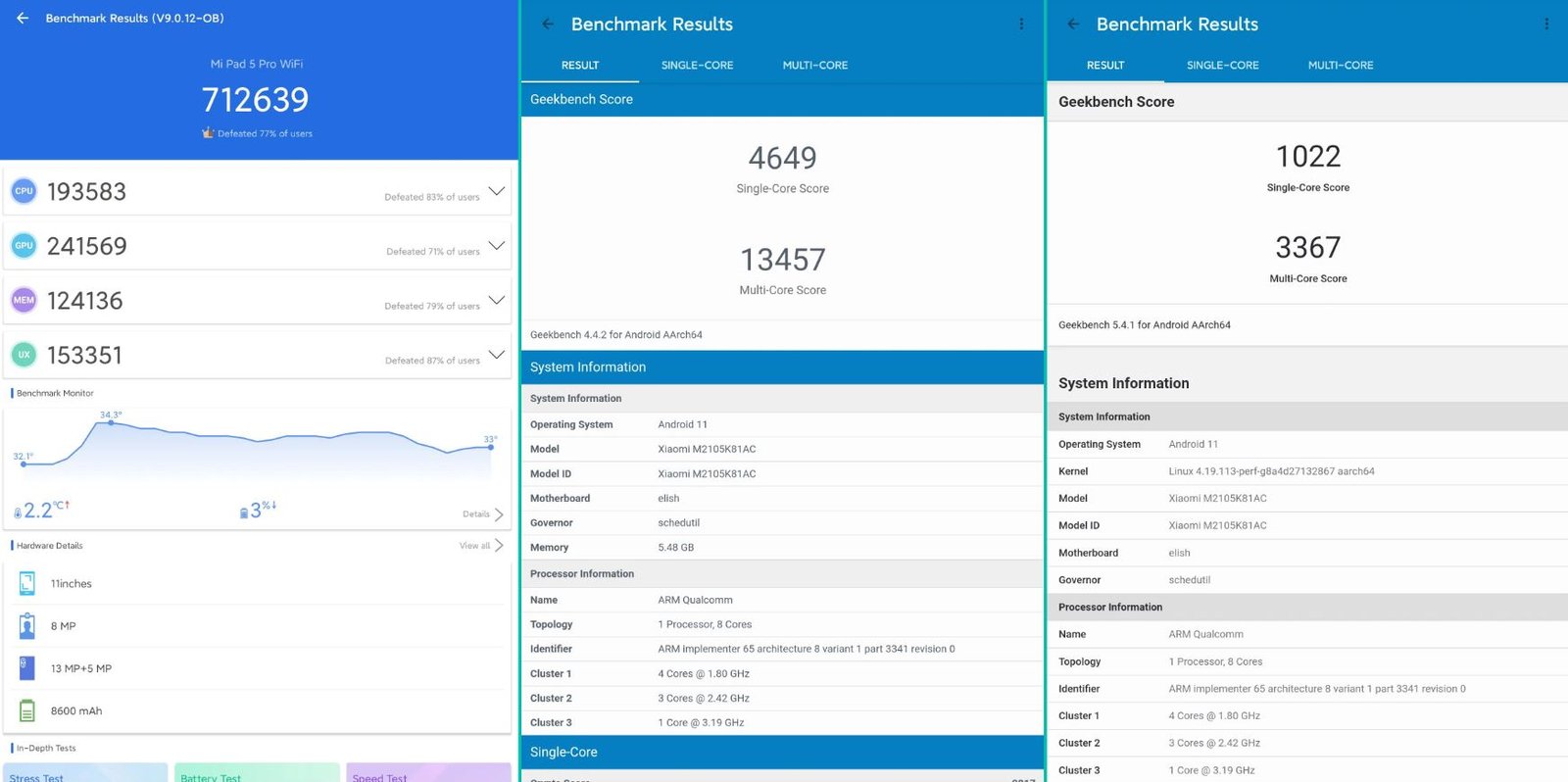

The read and write rates of the internal memory and the working memory are very good . This means there is no bottleneck because something in the system is too slow and therefore, the required data cannot be delivered quickly enough. very good.

Benchmark results of the Xiaomi Pad 5
Aside from a slightly lower performance, the Mi Pad 5 works very well. In fact, the Mi Pad 5 has a slightly faster RAM than the Mi Pad 5 Pro, which is actually faster. But the lower performance or working memory doesn’t matter in everyday life. Here, you can play or use everything that the Google Play Store has to offer.

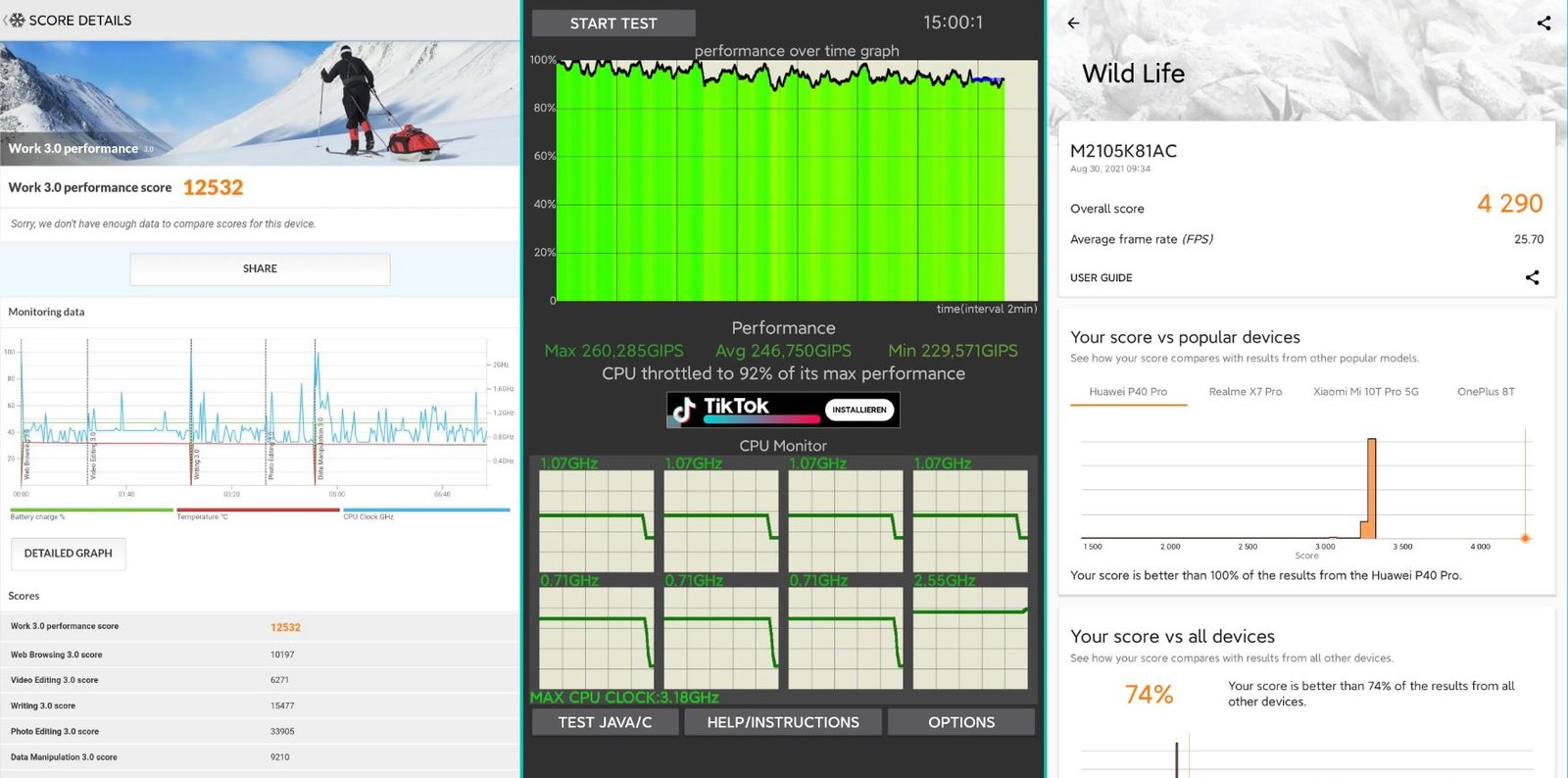
In the CPU stress test, the Mi Pad 5 also performed very well, even slightly better than the Pro model.

MIUI OS
The operating system should be fun to use. Naturally, this is still MIUI on Android 11. However, a few clever changes were made. Because tablets have a bigger screen, there is much more room for content, and you may sometimes need to do something different.
Camera
Let’s quickly move on to the next point, which is in the camera itself. Now notice that the design of the camera layout is exactly the same as the pro, and to be honest it’s very difficult to see it, but on the non-pro version there is only one single sensor right here, a 13 megapixel sensor, whereas on the pro you have an additional 5 megapixel dev sensor.

Connectivity
In terms of connectivity, the non-pro version has Bluetooth 5.0, whereas the pro version has Bluetooth 5.2, which means less latency and a slightly wider range, but again, in day-to-day use, there isn’t much of a difference. The second consideration is the WiFi speeds. However, the Mi 5 supports Wi-Fi 5, and the Mi 5 Pro supports Wi-Fi 6.
First and foremost, neither device has a headphone jack, so all you headphone lovers out there will have to rely on Bluetooth. Second, neither device has haptic engines, so you will not feel any vibrations in the device, which is standard on tablets these days. Finally, neither device supports video out, so even if you have a HDMI or Type-C connector, you will not be able to extend your display to an external monitor.
Battery life
The battery capacity of the two models is almost the same: 8720mAh (Pad 5) and 8600mAh (Pad 5 Pro). But the Pad 5 Pro can be charged at 67 watts, which is a lot faster. Not that the 33 watts in the Pad 5 aren’t already pleasantly fast.
Conclusion!
Mi Pad 5 Pro has few flaws. The design, construction, feel, performance, and 120 Hz display make you happy. It’s a pity that you can get by with Chinese or English system language and also have to install the Play Store manually.
The differences between the Pad 5 and the Pad 5 Pro are rather marginal and not of enormous proportions.
No GPS, dual-band WLAN, and fingerprint sensor. Everyday use is unaffected by the slightly lower performance.
Amazon Prime Video prevents the digital rights management plan by only supporting Widevine L1. Maybe an upcoming update will help?
If you want a fast, large tablet for a low price, the Chinese import version is for you. The global Mi Pad 5 surcharge is small. If you can accept the small compromises.
The price of Mi Pad 5 is 70$ more expensive than import. At $399 you can get a lot of tablets from Samsung. Here Xiaomi has yet to prove itself, and if it’s about the falling price. especially since the competition offers full Widevine support.
